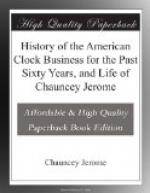The next summer I lost seven hundred and forty dollars by Moses Galpin of Bethlem. Five or six others with myself trusted this man Galpin with a large quantity of clocks, and he took them to Louisiana to sell in the fall of 1821. In the course of the winter he was taken sick and died there. One of his pedlars came home the next spring without one dollar in money; the creditors were called together to see what had better be done. The note that he had given me the fall before was due in July, and I as much expected it as I did the sun to rise and set. Here was trouble indeed; it was a great sum of money to lose, and what to do I didn’t know. The creditors had several meetings and finally concluded to send out a man to look after the property that was scattered through the state. He could not go without money. We thought if we furnished him with means to go and finish up the business, we should certainly get enough to pay the original debt. It was agreed that we should raise a certain sum, and that each one should pay in proportion to the amount of his claim. My part was one hundred dollars, and it was a hard job for me to raise so large a sum after my great loss. When it came fall and time for him to start, I managed in some way to have it ready. This man’s name was Isaac Turner, about fifty years old, and said to be very respectable. He started out and traveled all over the state, but found every thing in the worst kind of shape. The men to whom Galpin had sold would not pay when they heard that he was dead. Mr. Turner was gone from home ten months, but instead of his returning with money for us, we were obliged to pay money that he had borrowed to get home with, besides his expenses for the ten months that he was gone. This was harder for me than any of the others, and was indeed a bitter pill. As it was my first heavy loss I could not help feeling very bad.
In the winter and spring of 1822, I built a small shop in Bristol, for making the cases only, as all of the others made the movements. The first circular saw ever used there was put up by myself in 1822, and this was the commencement of making cases by machinery in that town, which has since been so renowned for its clock productions. I went on making cases in a small way for a year or two, sometimes putting in a few movements and selling them, but not making much money. The clocks of Terry and Thomas sold first rate, and it was quite difficult to buy any of the movements, as no others were making the Patent Clock at that time. I was determined to have some movements to case, and went to Chauncey Boardman, who had formerly made the old fashioned hang-up movements, and told him I wanted him to make me two hundred of his kind with such alterations as I should suggest. He said he would make them for me. I had them altered and made so as to take a case about four feet long, which I made out of pine, richly stained and varnished. This made a good clock for time and suited farmers first rate.




